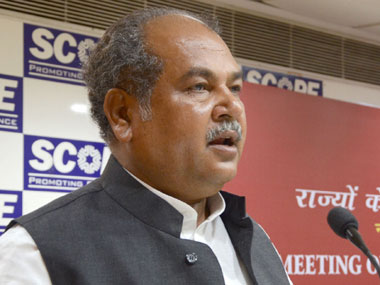Prime Minister Narendra Modi has inducted five Members of Parliament from Madhya Pradesh as ministers in his team . This may be seen as a reward for the BJP’s performance in Madhya Pradesh, where it won all seats barring one, despite the state having a Congress government.
Although the BJP lost the Assembly elections in 2018, the party won 28 seats in the recently-concluded Lok Sabha election (as compared to 27 seats in 2014). In fact, when the Lok Sabha polls were contested, the BJP held only 26 seats, as the Congress had won a bypoll and increased its tally to three seats.
In the 2019 election, the BJP proved speculations and calculations of political pundits wrong, and reduced the Congress to just one seat — Chhindwara. Although the Congress had wrested power from the BJP in the state after 15 years, the grand old party had failed to leverage its performance to increase its tally in the Lok Sabha election.
The five persons from Madhya Pradesh who have been named as ministers are Narendra Tomar (Agriculture, Farmers’ Welfare and Rural Development), Thaawar Chand Gehlot (Social Justice and Empowerment), Dharmendra Pradhan (Petroleum, Natural Gas and Steel), Prahlad Singh Patel (MoS, Independent charge: Culture) and Faggan Singh Kulaste (MoS, Steel). The first three of these are Cabinet ministers. Although Pradhan is from Odisha, he is a Rajya Sabha member from Madhya Pradesh.
From the three states that the Congress had won from the BJP in last year’s Assembly elections (Madhya Pradesh, Chhattisgarh and Rajasthan), nine MPs have been given ministerial berths in the NDA 2.0 government. In all these states, issues of agraian distress and tribal welfare hold significance.
The three ministers from Rajasthan are: Gajendra Singh Shekhawat (Cabinet minister, Jal Shakti), Kailash Choudhary (MoS, Agriculture and Farmers welfare) and Arjun Meghwal (MoS, Parliamentary Affairs). From Chhattisgarh, Renuka Singh Saruta (MoS, Tribal Affairs) has been appointed as a minister.
What makes Madhya Pradesh important?
Madhya Pradesh has less than half the number of Lok Sabha seats (29) as compared to Uttar Pradesh (80). However, the number of ministers from the state (five) is half of the number of ministers from Uttar Pradesh (ten). This shows the political importance of the central state.
During the first NDA government, seven MPs from Madhya Pradesh had got ministerial berths, while one (Sumitra Mahajan) had become the Lok Sabha Speaker.
Earlier also, during the tenures of Indira Gandhi and Rajiv Gandhi, several notable MPs from Madhya Pradesh had become ministers, such as Vidya Charan Shukla, Madhavrao Scindia, Arjun Singh, Suresh Pachouri, Arvind Netam, etc. More recently, in the UPA years, Kamal Nath, Jyotiraditya Scindia and Arun Yadav had become central ministers.
Shankar Dayal Sharma, who was the chief minister of the erstwhile Bhopal state from 1952 to 1956, had later become the President of India (1992-1996).
However, it is in the NDA regime that the maximum number of MPs from the state have been made ministers at the Centre.
By giving ministerial berths to Gehlot, Patel and Kulaste, Modi appears to have sought to reach out to people belonging to Scheduled Castes, OBCs and tribals respectively.
Gehlot, considered close to Modi, represents the Balai community, which is included among the Scheduled Castes, and has a significant presence in Madhya Pradesh, Chhattisgarh and Rajasthan. Patel belongs to the Lodhi community, which is included among the OBCs. Patel has an image of a firebrand labour leader, and had also been a minister in the Atal Bihari Vajpayee government.
Renuka Singh Saruta from Chhattisgarh’s Surguja is one of the BJP’s tribal faces. Parivesh Mishra, Chhattisgarh-based political commentator, said, “Saruta belongs to the Gond community, which has a presence throughout Chhattisgarh and is the single largest tribe in the state. Although she is a first-time MP, she had been a minister in the Raman Singh-led state government. This experience at the central level will help her to a certain extent. She has won with a margin of 1.5 lakh votes – the highest among the three tribal seats won by the BJP in Chhattisgarh. Her appointment as an MoS will send a strong positive message among tribals.”
During the 2018 Assembly elections in the three Hindi heartland states, farmer distress had emerged as a major issue. In 2017, Mandsaur district in Madhya Pradesh had witnessed a farmers’ agitation which saw large-scale mob violence. Six people were killed in police firing in the district.
It may have been a strategic move by Modi to appoint a Cabinet minister and Minister of State for Agriculture and Farmers Welfare from Madhya Pradesh and Rajasthan respectively. Similarly, the appointment of two tribal Ministers of State (one each from Madhya Pradesh and Chhattisgarh) may be seen as an attempt to consolidate the tribal vote bank.
The appointment of Tomar as a Cabinet minister for the second time in a row is a recognition of his strong organisational skills. He had been the Madhya Pradesh BJP chief for two terms. During his tenure, the party had won two consecutive Assembly elections.


)




)
)
)
)
)
)
)
)